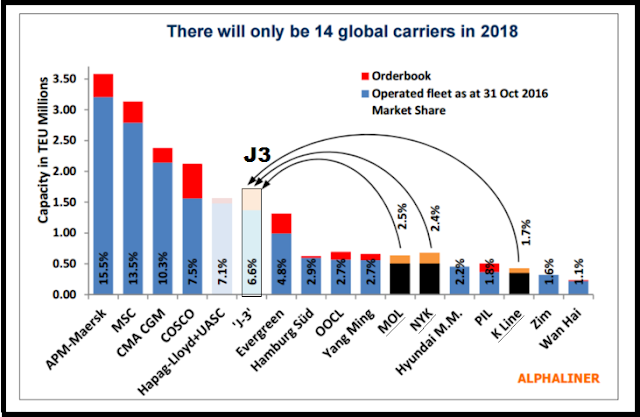The container-shipping industry has been highly unprofitable
over the past five years. Making things worse, earnings have been exceptionally
volatile. Several factors are responsible, notably trade’s spotty recovery from
the global financial crisis, and redoubled efforts by corporate customers to
control costs. Some of the pain is self-inflicted: as in past cycles, the
industry extrapolated the good times and foresaw an unsustainable rise in
demand. It is now building capacity that appears will be unneeded.
These problems are real and significant, and largely beyond the
power of any one company to address. But shipping companies cannot afford to
throw up their hands and accept their fate.
These developments
are leading to alliances, mergers, acquisitions & sale!
Latest in the race is Hamburg Süd. The owners of Hamburg Süd are
tipped to opt for an outright sale rather than a merger. A sale of the Hamburg
Süd by the family owners Oetker conglomerate, which runs the gamut from pizza
and beer to financial services and shipping, would accelerate the consolidation
that has significantly reshaped the financially troubled industry this year.
Who are the buyers?
On 1st December 2016 - Maersk Line and the Oetker Group have reached an agreement for Maersk Line to acquire Hamburg Süd, the German container shipping line. The acquisition is subject to final agreement and regulatory approvals.
On 1st December 2016 - Maersk Line and the Oetker Group have reached an agreement for Maersk Line to acquire Hamburg Süd, the German container shipping line. The acquisition is subject to final agreement and regulatory approvals.
Maersk CEO Soren Skou confirmed in September that Maersk Line is
mulling acquisitions in its bid to grow in line with the market when he
unveiled the group’s new strategy that will split its shipping, ports, and logistics
operations from its energy division.
One company's loss is Another company's gain!
Hamburg-Süd has twice held merger talks with Hapag-Lloyd, most
recently in 2012 and 2013, but the companies failed to agree on shares in an
enlarged carrier. Hapag-Lloyd last week secured approval from the European
Union for its takeover of United Arab Shipping Company.
Up for sale? Who is
next?
Hamburg Süd, along
with Orient Overseas Container Line, Yang Ming Line, Hyundai Merchant Marine,
and Zim Integrated Shipping Services, are coming under increasing pressure to
consolidate following a spate of merger and acquisition deals that have seen
the market leaders pull ahead of mid-ranked carriers.
Hamburg Süd – as a line
Hamburg Süd has focused on north-south routes, particularly
Latin America, where it strengthened its position with the $160 million
acquisition of the container line services of Chile’s CCNI in 2015, and
recently moved into the east-west market through a cooperation agreement with
UASC.
The carrier operates a fleet of 116 ships — 44 owned and 72
chartered — with an aggregate capacity of 600,344 twenty-foot-equivalent units
and a market share of 2.9 percent, according to industry analyst Alphaliner. It
has eight ships of 30,400 TEUs on order.
The Hamburg-based line, which is also involved in bulk shipping
and product tankers, boosted revenue by almost 17 percent in 2015 to just over
6 billion euros ($6.4 billion) driven by the acquisition of CCNI and its debut
on the east-west liner trades. Container traffic last year was up 21.5 percent
at 4.1 million TEUs.
Unlike the majority of its competitors, Hamburg Süd is not a
member of an alliance. The company does not publish profit and loss figures.










